Sharing all the nitty-gritty details, tips and tricks to make foolproof choux pastry and create beautiful pastry shells every single time! Step by step photos and video tutorial included.
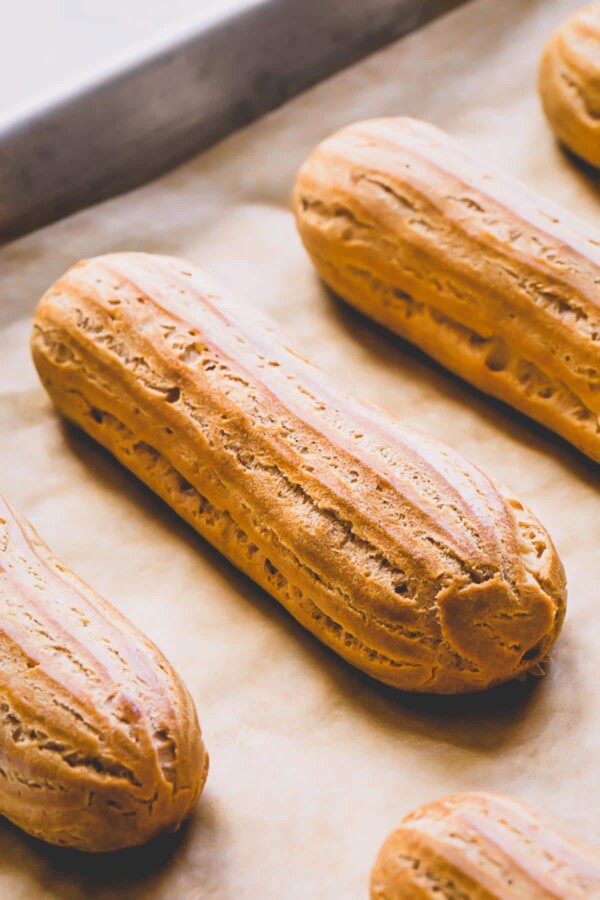
Table of Contents
What is choux pastry?
Choux pastry (pronounced like “shoo”) is a twice-cooked pastry dough, originated in France. It’s pâte à choux, in French.
It’s quite a versatile dough and is a foundation for many different pastries, like classic eclairs, cream puffs, profiteroles, craquelin, or savory appetizers like gougères.
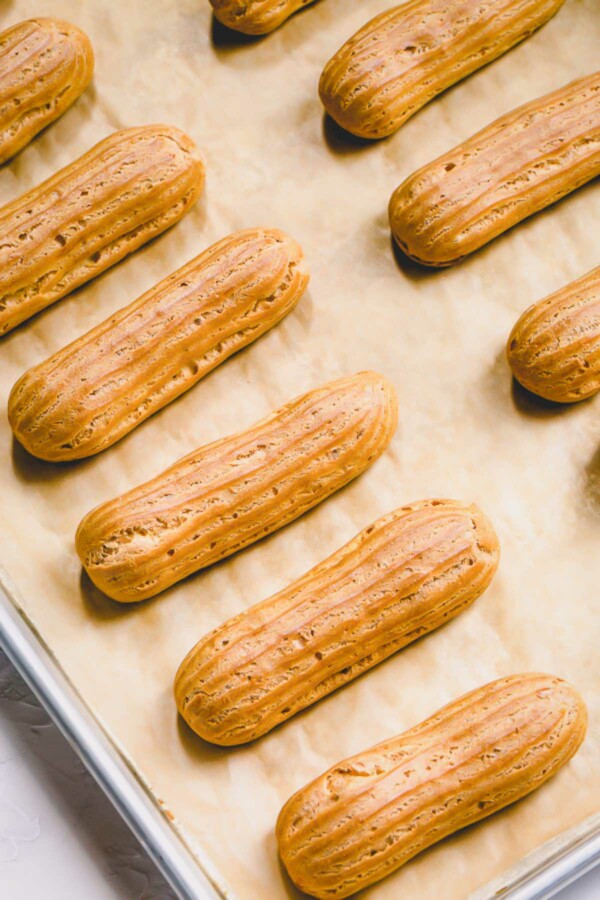
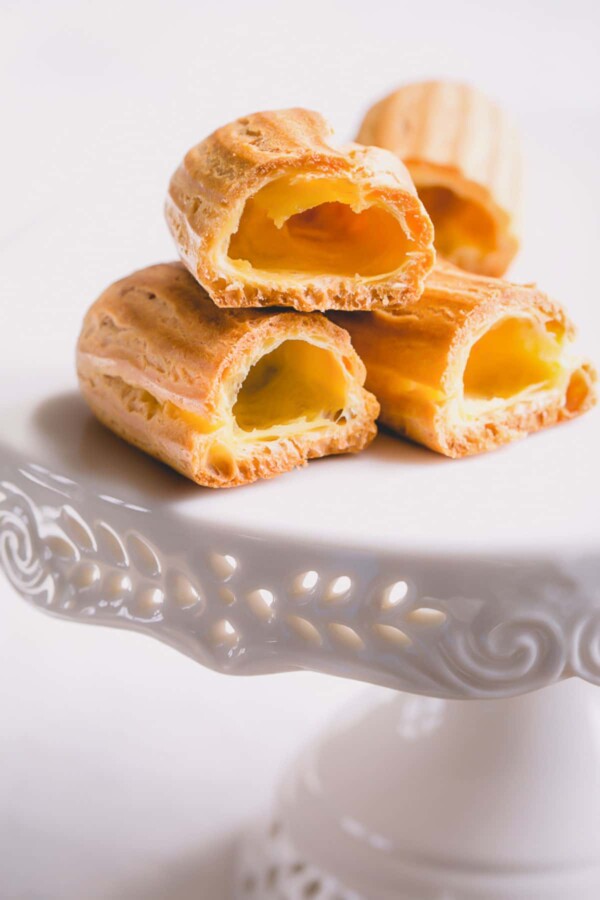
Why you’ll love this recipe:
- It’s incredibly simple and easy to make this pastry dough! And it requires basic pantry staples.
- In today’s post, you’ll find my time-tested recipe with step by step photos and a video, as well as lots of tips for success.
- And at the end, you’ll find a comprehensive troubleshooting guide for frustrating issues like flat, deflated shells, too many uneven cracks, soggy doughy pastries, etc.
It’s a long one, so grab a cup of coffee and let’s talk all things choux pastry.
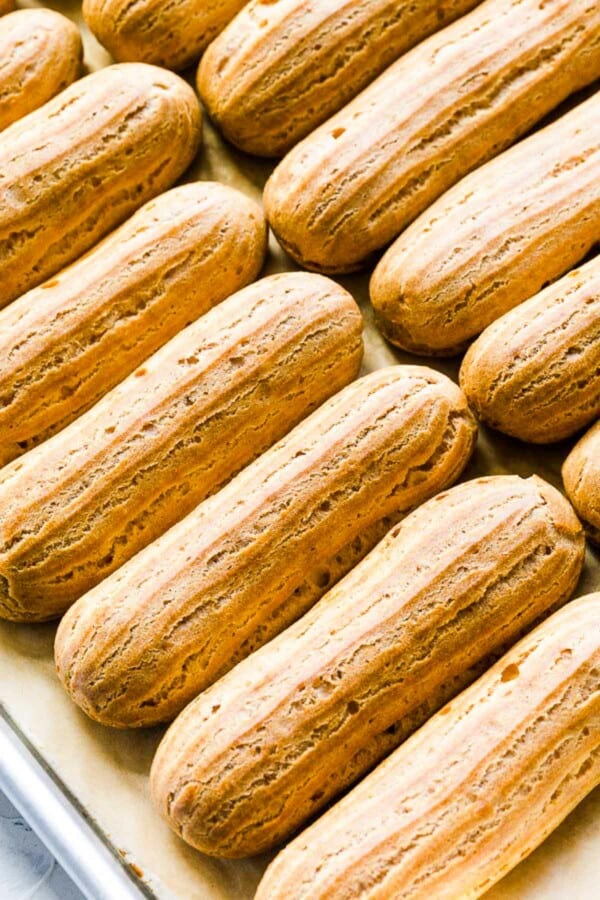
Ingredients Notes:
As mentioned above, you’ll need very basic ingredients.
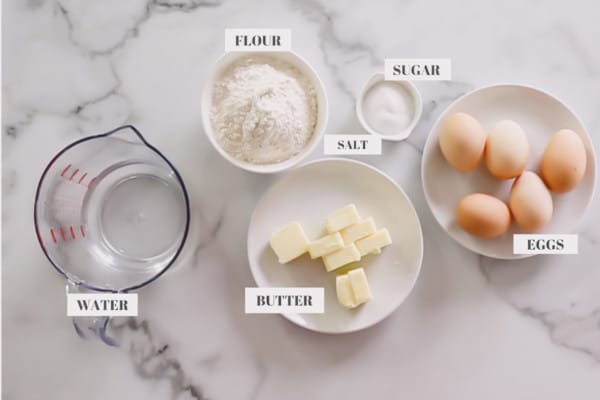
- Liquid – You can use either water or milk, or a combination of both. Water yields slightly crisper shells, while milk makes the shells a bit more tender.
- Flour – If you want crispy pastry, use high protein flour, like bread flour. All-purpose flour works fine too.
- Butter – I prefer unsalted butter. If you opt for salted butter, omit the salt.
- Sugar – A little bit of sugar not only adds flavor, but it also helps with browning. It’s optional though!
- Eggs play crucial part in this recipe, as it’s a main leavening agent that gives eclairs light and airy texture!
How to make pâte à choux:
1. Make panade
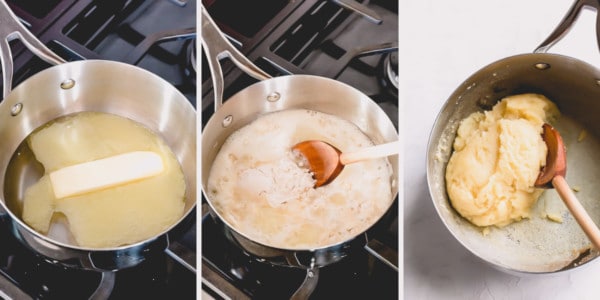
- Slowly heat water, butter, sugar and salt over medium low heat, stirring occasionally. The goal is to melt butter and dissolve sugar and salt before the mixture comes to a boil.
- Meanwhile, sift the flour. It helps to remove any lumps, so it incorporates into the dough better.
- Off heat, add all the flour at once into the butter mixture.
- Once all the flour is incorporated, cook the dough over medium high heat for about 5 minutes, or until it reaches 175°F.
Tip
Don’t boil the water for too long before adding flour, or you’ll evaporate too much water and get the ratio of wet and dry ingredients off.
2. Add eggs
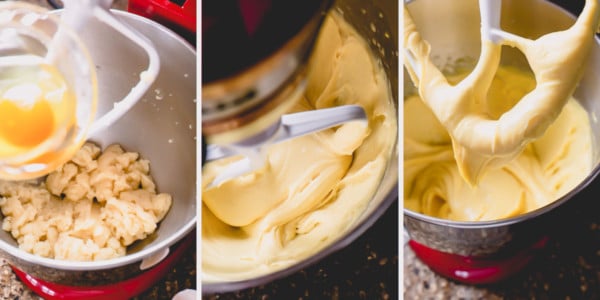
Tip
When cooling the dough, don’t beat it for too long, or on high speed, because it can cause the fat to separate, which can result large cracks in baked pastry shells.
- Cool the dough to room temperature before adding the eggs. You can just leave it for about 10 minutes, or beat it in a stand mixer with paddle attachment on low speed for 2-3 minutes.
- Add the eggs one at a time, mixing the mixture really well after each addition.
- It’s totally normal for the dough to break and look weird. But continue beating and adding the eggs, allowing each egg absorb into the dough completely before adding the next.
- Check the consistency of the dough after 4th egg. You may not need the last egg. Too much eggs will cause a runny dough, which will result flat pastry shells.
Tip
The proper consistency of batter is important, because it can make or break your final outcome.
Too runny batter will make flat shells, too thick batter is hard to pipe.
Batter consistency
The batter should be smooth, thick and glossy.
And when you lift the beater, the dough should slowly fall into a thick ribbon, leaving a V shape at the end.
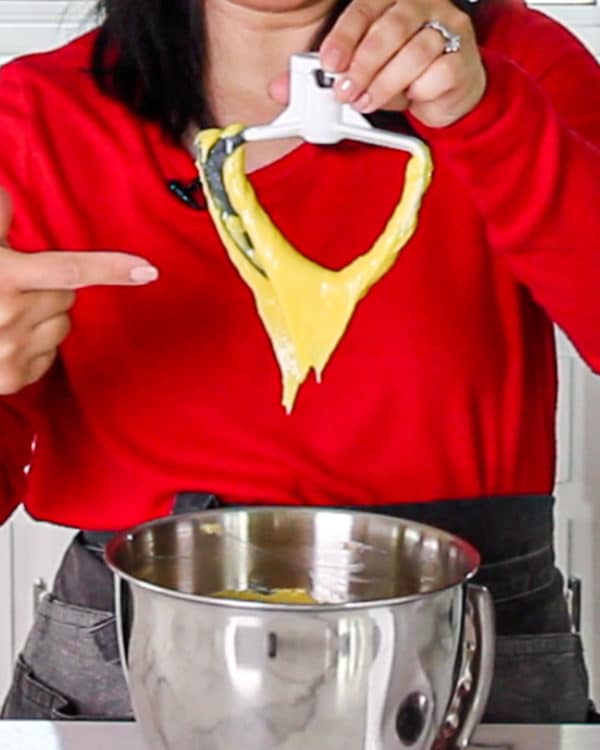
Following are a few factors that affect how many eggs your dough may need:
- how long the panade was cooked
- how big or small your eggs are
- type of flour you’re using. For example, more glutenous the flour, more eggs it needs.
3. Shape the pastries
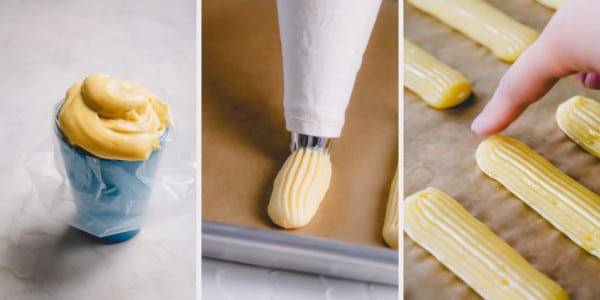
Tip
Place the pastry bag in a tall glass, as shown above. It’s much easier to fill it this way!
- Place a piping tip in a large pastry bag. I like to use this round tip to pipe rounds for cream puffs, and this star tip for eclairs. If you’d like, you can also find special French pastry star tip that is perfect for piping eclairs.
- Transfer the dough into the pastry bag (I use this 16″ disposable pastry bag and 18″ reusable canvas pastry bag).
- Rest the batter for about an hour before piping.
- Hold the pastry bag at 45° angle and pipe with a consistent pressure. This may require a little bit of practice. If you don’t get it right away, don’t fret. I promise, those pastry shells will taste just as delicious!
- Flatten the pointy ends with wet fingertip. Simply dip your finger in a bowl of water before flattening the dough to prevent the dough sticking to the finger. If not flattened, those pointy ends will burn and won’t look pretty.
Tip
Uncooked choux pastry dough can be stored in the fridge for up to 2 days. I like to put the dough in a pastry bag, tightly close both ends and refrigerate until ready to use.
4. Bake
- Bake the pastry at 375°F for 30-35 minutes, or until puffed and golden brown.
- For best results, bake one baking sheet at a time. You can bake 2 sheets a time, rotating them half way into the baking, but you risk collapsing the shells. (See why in the next point.)
- Don’t open oven door until the shells are set and golden brown, for at least first 20-25 minutes! Why? These pastry shells need all the steam to puff up and set into shape during baking. And if you open the oven door before the shells get a chance to set properly, the steam will escape, deflating the shells.
RECIPE TESTING NOTES: Some recipes instruct to bake the shells at high temperature first, then lowering the temperature for the remaining bake time. I’ve tested it many different ways, and find baking choux pastry at consistent temperature yields the same, if not better results.
Whew, are you still with me? Kuddos to you for sticking with me!
Again, I wanted this post to be your go-to guide for mastering choux pastry. That’s why I took you step by step through entire process sharing everything I know about this versatile pastry dough. Hope these tips and tricks will help you achieve beautiful, professional looking desserts and appetizers.
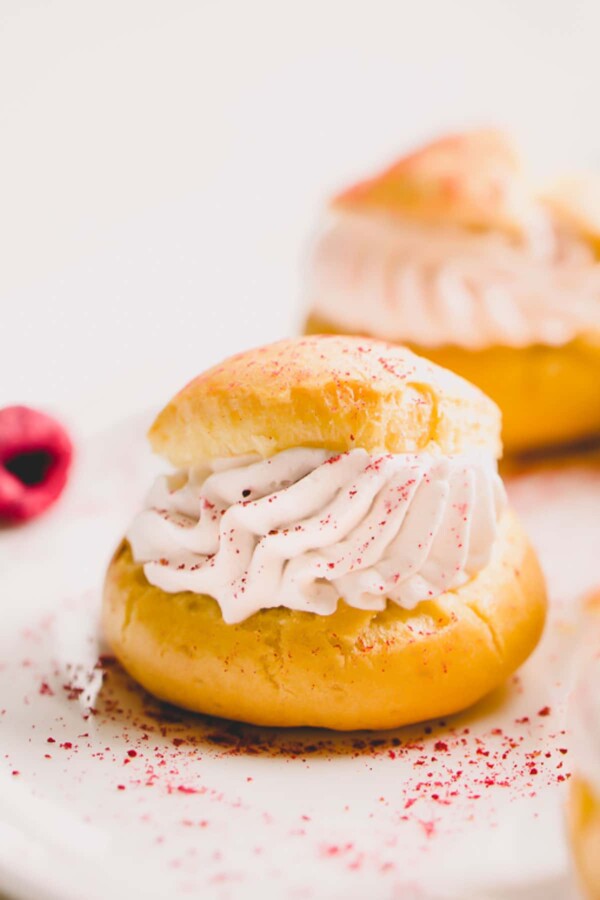
Pate a choux troubleshooting
You probably added too much eggs.
FIX #1: Don’t just add raw flour into the runny dough to thicken it, you won’t get the proper pastry shells that way. Instead, make a half batch of dough on stovetop (without eggs) and mix it in with the runny choux pastry.
FIX #2: Next time, add the eggs one at a time and check the consistency of the dough after the 3rd egg and additional egg as needed.
1. Dry ingredients haven’t been dissolved/incorporated completely.
FIX: Make sure sugar and salt are fully dissolved before water mixture comes to a boil. And make sure to sift the flour to remove any lumps, and vigorously mix the dough once you add the flour all at once.
2. Dough may have been beaten for too long, or at high speed before adding the eggs, causing the fat to separate from dough.
FIX: Next time don’t beat the dough for too long, or make sure to beat at low speed for no longer than 3 minutes.
3. Pastry shells may have been baked at too high temperature, making the dough rise at a rapid speed.
FIX: Try baking the pastry shells at a constant temperature.
4. Pastry shells weren’t piped smoothly. Any wavy ripples will crack during baking.
FIX: Pipe smooth shells with even consistent pressure without ripples. Also star tip for piping long eclairs helps the pastry bake with even shape.
1. Runny choux pastry could cause flat eclairs, cream puffs, etc.
FIX: See runny pastry dough section above.
2. You opened the oven door too soon.
FIX: Don’t open the oven door for at least first 25 minutes. Open the oven door only when the pastry shells are nice and golden.
3. The pastry shells weren’t baked long enough.
FIX: Put the baking sheet with pastry shells right back into the oven and bake longer.
You didn’t make slit on the side of shells to allow steam to escape in the last 5 minutes of baking.
FIX: Make sure to make a small slit (0.5-inch slit) and bake for 5 minutes before removing the baking sheet out of the oven.
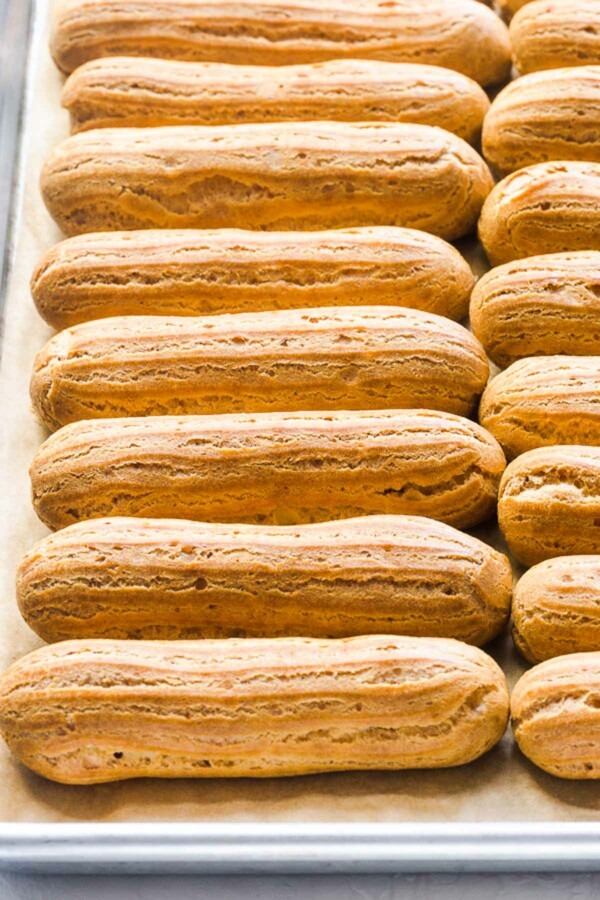
CHOUX PASTRY FAQ:
- Why some recipes call for combination of water and milk?
- Choux pastry made with milk comes out richer and more tender. I like to use combination of milk when I’m making cream puffs, or profiteroles.
- Can make choux pastry in advance?
- Yes, absolutely. Uncooked choux pastry dough can be stored in an airtight container (or pastry bag) in the fridge for up to 2 days.
- Can I freeze baked pastry shells?
- Yes, you can! Baked pastry shells without filling freeze beautifully. Put them in a ziplock bag and freeze for up to 3 months. To fill, thaw the shells in the fridge and then bake them at 300°F for 8-10 minutes.
Video Tutorial:
More Favorites from Sweet & Savory
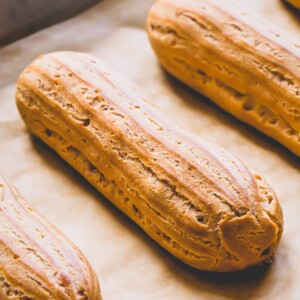
How to Make Choux Pastry
Ingredients
- 1 cup (240 ml) water Note 1
- ½ cup (115 g) unsalted butter Note 2
- 1 tablespoon granulated sugar
- ¼ teaspoon salt
- 1 cup (125 g) all-purpose flour sifted Note 3
- 4-5 large eggs at room temperature Note 4
Instructions
- In a medium saucepan, combine water, butter, sugar and salt. Slowly heat the mixture over medium heat, stirring frequently to dissolve sugar and melt the butter. Once sugar is dissolved and butter is melted, increase the heat to medium high heat and bring the mixture to a boil.
- When the mixture comes to a boil, remove the saucepan from heat and add flour all at once. Quickly mix the mixture until all the flour is absorbed. (We just made panade!)
- Replace the saucepan back to burner and reduce the heat to medium. Cook the dough, continuously mixing with a wooden spoon. The dough will start to form into a ball. Keep mixing for another 3-4 minutes until light crust forms on the bottom of the pan. (Note: It's important to cook for at least 3-4 minutes to dry out the panade.)
- Transfer the dough into a mixing bowl with paddle attachment and mix it for a few minutes on low speed until the mixture is at room temperature, about 2 minutes. (No mixer? No problem. You can mix it with a wooden spoon!)
- Add eggs one at a time, beating well after each addition. This will help to get egg absorbed into the dough quicker. Don’t add more than 2 eggs at a time! This's especially important, as you might not need to the last egg. The dough should be smooth and shiny, thin enough to slowly fall into a ribbon, but too runny. (See visual cues in the post above, or in the video!)
- Transfer the batter into a large pastry bag and rest for at least 1 hour. At this point choux pastry is done and ready to be piped into whatever size you want. Uncooked dough can also be refrigerated for up to 3 days in an airtight container.
- Preheat oven to 375°F (190°C) about 30 minutes prior to baking the choux pastries. Line 2 baking sheets with parchment paper, or silicone mat.
- To cook pastry shells, pipe the batter into desired shape, depending on what you're making. For eclairs, pipe into 4-inch strips, for cream puffs pipe into 2-inch rounds 3 inches apart.
- Level peaked tops with a wet fingertip.
- Bake, one baking sheet at a time, for 30-35 minutes, or until the shells are puffed up and golden brown. (Note: Don't open the oven door the first 25 minutes.)
- After initial 30 minutes, quickly open the oven door and make a small slit on the side of shells, using a small sharp pairing knife. This allows the steam to escape and helps to dry out the inside of pastry shells. Bake for another 5 minutes, or until shells are crisp and golden brown.
- Transfer the shells onto a wire rack and cool completely before filling.
Tips & Notes
The choux pastry dough can be made and refrigerated for up to 3 days. Baked, unfilled shells can be stored at room temperature in an airtight container for 1 day, or frozen for up to 3 months.
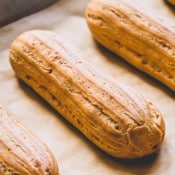

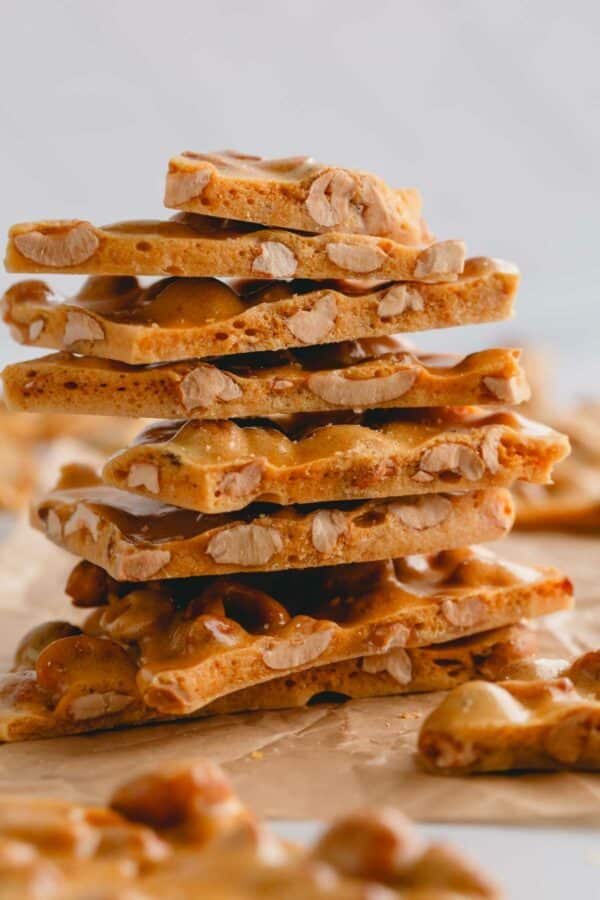
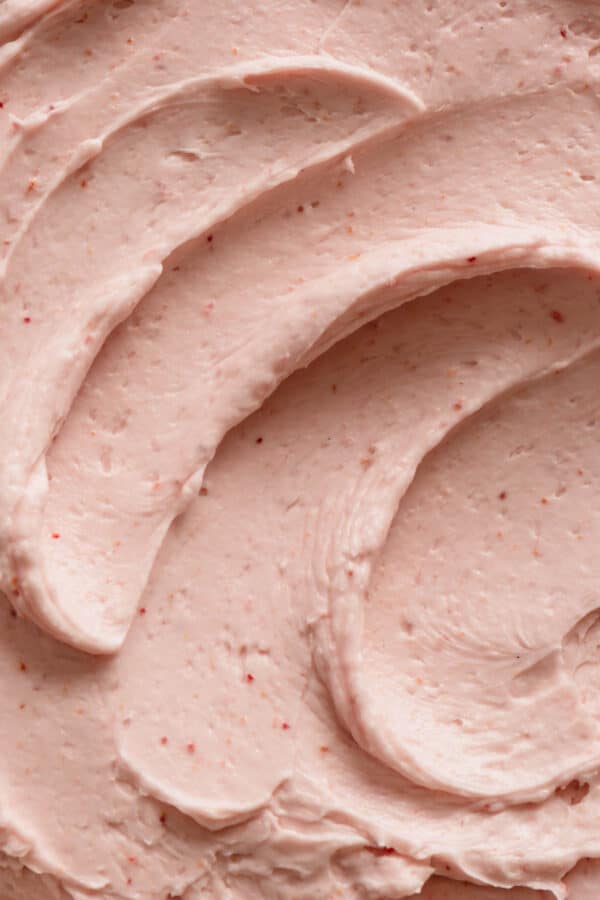
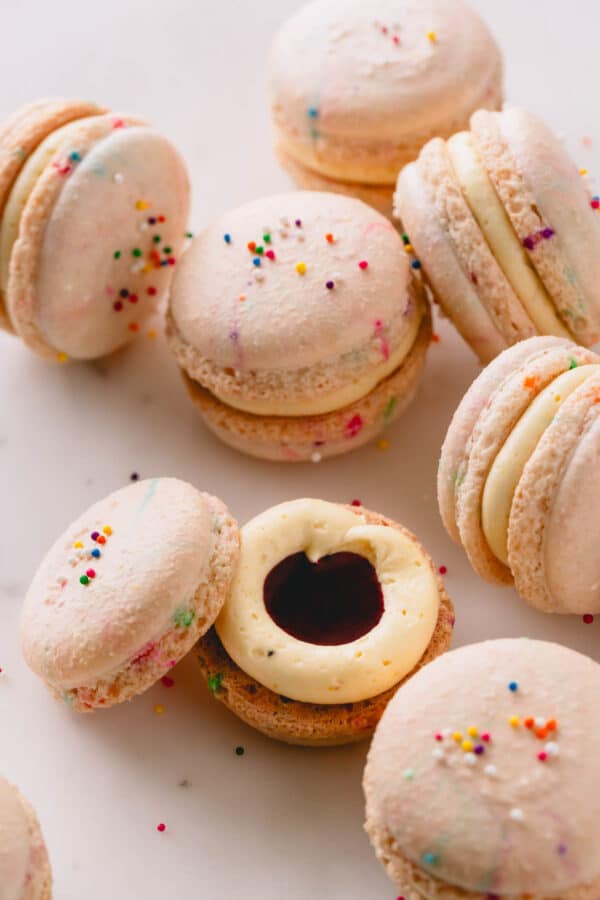
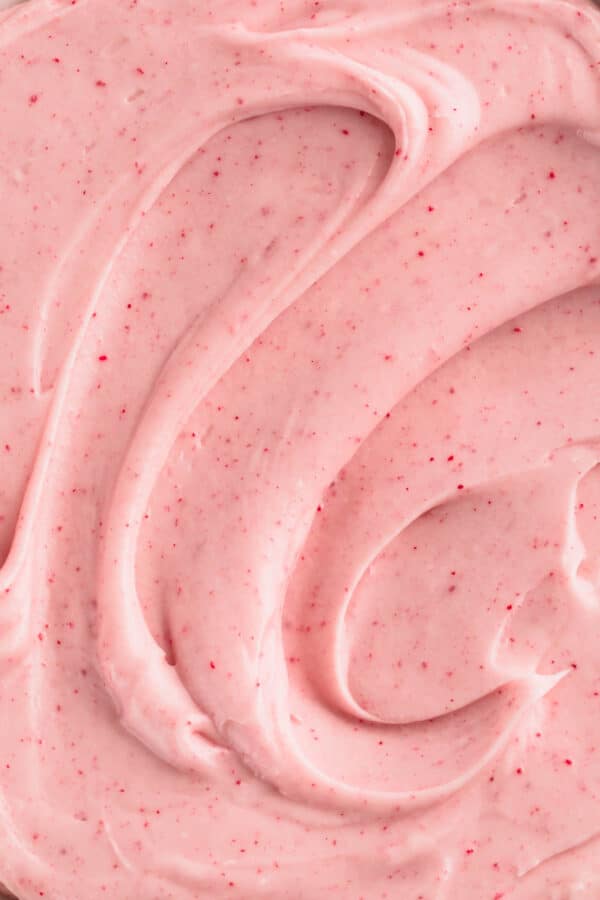

Hi, I made these with my dad and we are unsure how we messed them up. The bottoms concaved and the the shells only puffed up a little. I was hoping that once we sliced them, the bottoms would flatten out a bit but that didn’t happen. Any advice?
Hi, Colleen. There’re a few things may have caused the issue. 1. Did you cool the dough before adding the eggs? It’s crucial to cool the hot dough before adding the eggs, so that eggs don’t cook. Or the shells won’t rise properly. 2. How many eggs did yo used? And what was the consistency of the batter? Too runny batter causes flat shells too. 3. Or it’s possible the shells weren’t cooked long enough. Did you notice if the shells were puffy in the oven and they collapsed after they came out of the oven?
Thanks! We transferred the dough to a metal bowl and it took a long time for it to cool before adding the eggs. I’m thinking the metal bowl didn’t allow it to cool fast enough. Even with mixing it took over 15 minutes to cool and it may not have been cool enough. Plus we may have over mixed it.
We did use 5 eggs because it seemed too thick without the 5th egg but next time I may try 4.
The shells seemed to be cooked enough but maybe they weren’t. Looks like we will have some trial and error until we get the perfect pastry shell. Thanks for the suggestions! The taste was great, just what we hoped for… looking forward to adding a nice Italian pastry cream to it eventually.
Thanks for your great info and instructions for making choux pastry! I made two batches that had to be thrown away before I came upon this recipe and tried one more time – and this time my cream puffs were perfect and received rave reviews!
Yay, so happy you came across my post and that it was helpful!!! Thank you, Rebecca, for sharing your feedback!
I hope you can read this. I have this problem. all of my cream puffs looks good in the oven but when I remove the cream puff in the oven the bottom part of it was stuck in the parchment paper. what is the reason for it and how to fix it. It was so frustrating that my whole batch was like that. please help
Hi, Michael. That’s an interesting issue that I’ve never had before. Were they otherwise cooked through, didn’t deflate or anything? If so, what kind (brand) of parchment paper did you use?
I just noticed that I was using wax paper instead of parchment paper my bad. but another problem is sometimes my choux pastry is flat, not raised properly but the other batch has this great hollow inside. is there a reason behind it? what should I do?
Hi I got a beautiful choux au craquelin that was delightfully crisp the day it was baked. I kept the empty shells in an airtight container after they cooled but the very next day they become soggy. Is that normal or did I do something wrong?
Hi, Cheri. You know, I’ll be honest. I’ve never made choux au craquelin, and I’m not sure if it’s anything particular to choux au craquelin. But for unfilled eclair shells, they usually stay crisp when stored in an airtight container.
To keep them crisp, I put in the oven with the light on if it’s to humid to leave on the counter. I like mine to stay crispy. Or turn on oven to 325° for 5 min. & craqulin will crisp back up.
Ah, so helpful, Bea. Thank you for sharing your knowledge!!!
Hi, I hope you’re still seeing the comments and answering.
I wanna try making this twice this week–once for Wed and once for Sunday or Monday of next week. It’s over the two days in the fridge, so I’m wondering if I can store the pastry dough in the freezer, and if so, how to, or would it be best to just make a punch of puffs and freeze them? What would taste fresher on Sunday?
Hi, Christin. You can refrigerate the dough for up to 2 days, and bake the puffs the day before serving. Or you can bake the puffs and freeze them until the day of serving. I highly recommend filling the pastries the day you’re planning to serve though.
Hi,
I just made choux puffs, they really puffed up, crisp shell. But when I tasted one, with no filling, it was really eggy… I didn’t like it very much. Is this how it’s supposed to taste? Thank you, Roxana
Hi, Roxana. So, choux dough is made with lots of eggs. And if you have sensitive taste to eggs, it’s normal to think they’re eggy. However, to me (I’m not very sensitive to eggy flavor), I never felt like it’s eggy. Another thing to keep in mind, egg-based desserts taste extra-eggy when they’re warm or room temperature. Once cooled, or chilled completely, the egg taste subsides a lot. Also, once you fill the choux pastry with the filling, everything should taste balanced. Hope this helps, and I really hope you were able to enjoy them with filling. Thank you for your feedback!
Great tips! Baked them like a pro, my Parisien friend was so impressed, she ate more than a few 😜
Tried this recipe for the first time today and they turned pretty good in terms of taste. They were light a crisp too. The only problem is they didn’t puff up too much. Some not much at all to even really make any space in the middle. The ones that did puff out some did have a space. My first thought was there wasn’t enough water to generate steam but I was very careful to heat the water and butter slowly. Could it be because the tip I used was too small and there wasn’t enough material and water for them to really puff up? I thought they looked a little small when I piped them. I’ve never made or had eclairs before so I’m not 100%on the size but they look smaller than the ones I’ve seen in photos or TV.
Very detailed recipe by the way. Probably one of the best instructional ones I’ve read. Really appreciate how you explain not only what to do but why.
Hi, Daniel. Thank you for your feedback and providing details! I don’t think the size of piping time matters much, but not sure how small we’re talking about. Mine are a little wider than a finger, before baking.
There’re number of reasons that could prevent rise:
1. Too much moisture content in the batter. It’s important to cook the dough after adding the flour for at least 3 minutes, to evaporate excess moisture. Also was your batter too runny? If so, you may have added a bit too much egg.
2. Too much flour can make the batter too dense, thus prevent rise. How did you measure your flour? By cup or weight? I highly recommend weighing the ingredients.
3. Also, I’d suggest checking your oven temperature with an oven thermometer to make sure it heats properly. It’s very common for ovens vary up to 50° either way. So if your oven runs cooler, then you may need to adjust the temperature accordingly. Choux pastry needs high heat right away to puff up.
4. And lastly, make sure you don’t open the oven door for at least first 25min.
Hope this helps, let me know.
1. Perhaps I didn’t cook off enough moisture after I added the flour. The insides of them still felt moist as if they didn’t cook long enough even though they were in the oven for the entire time so maybe that was it. I even tried baking some for 50 minutes just to see if they were still moist on the inside and they were unfortunately. It was firm enough that the wooden spoon stayed upright before adding the eggs. It wasn’t runny after adding the eggs. It was thick and had the characteristic “v” shape when I lifted the beaters out.
2. I did not measure by weight. I’ll definitely do that next time to be more precise.
3. Not sure. It’s a pretty new gas convection range so I’ve never tested it with a thermometer. I did do a trial run baking at 425 for the first ten minutes as some other recipes suggest and I had more success with them puffing up. They were still moist on the inside though so I have to figure out that problem.
4. Didn’t open the oven for the first 25-30 minutes.
I am making Choux’s tomorrow…and I would like to fill them with a pumpkin cream.. any good recipes?!
Hi, Violet. I’m so sorry for my late response!! I actually had this pumpkin cream puff recipe here on my site, but I hope you found a good one as well.
Hi! I’m so excited to try this recipe! I had so much success with your macaron recipes (I made both the lemon macarons and the strawberry ones — so pretty and yummy!). I love how thorough your instructions are and all the trouble-shooting tips.
I’m totally new to pastry, so I have a couple of questions that might be silly — when it comes to parchment paper or silicone, is one better than the other for these or does it not matter?
Do I need to use a stainless steel saucepan for the crust to form when I am cooking the panade, or can I use a nonstick? Is there a way to tell if the panade is dry enough if a crust doesn’t form?
Thank you! I am so happy I found your blog! (And so are my friends and family members, who get to eat your recipes.)
Hi, Heather. I’m so, so happy you’re loving my recipes. I really didn’t notice any difference between parchment paper and silicone mat. I’ve tried baking eclairs on both, same result. And for panade, you can definitely use a non-stick saucepan, but you’re right, there won’t be any crust. But if you cook it for 3-4 minutes after the dough starts forming into a ball, you should be good. Hope you’ll love these eclairs/puffs. Let us know how they turn out. By the way, your family and friends are totally lucky to have you!!! 😉
Hi there, how long can the filled cream puffs stay out at room temperature ( about 70 degrees Fahrenheit)? I’m using them for a croquembouche and would like it to stay out as main edible centerpiece for as long as possible.
Hi, Michael. Ah, it’s really hard to say for me. But they should hold up pretty well for 5-6 hours. A lot depends on the filling too. Just for extra insurance, I’d suggest to over-bake the shells slightly. Let me know how it goes.